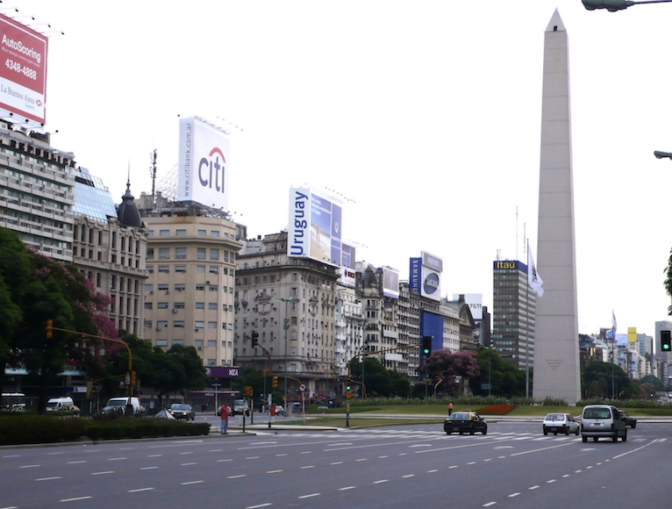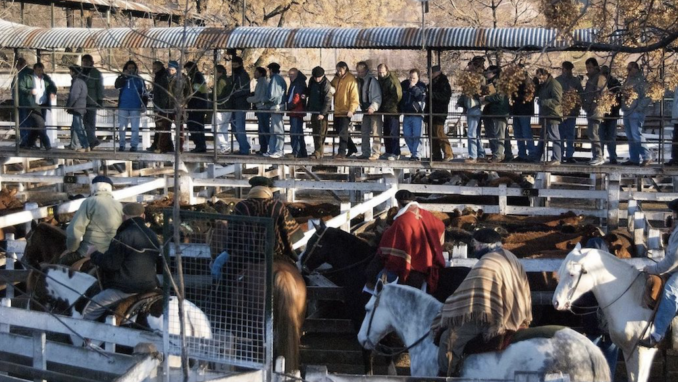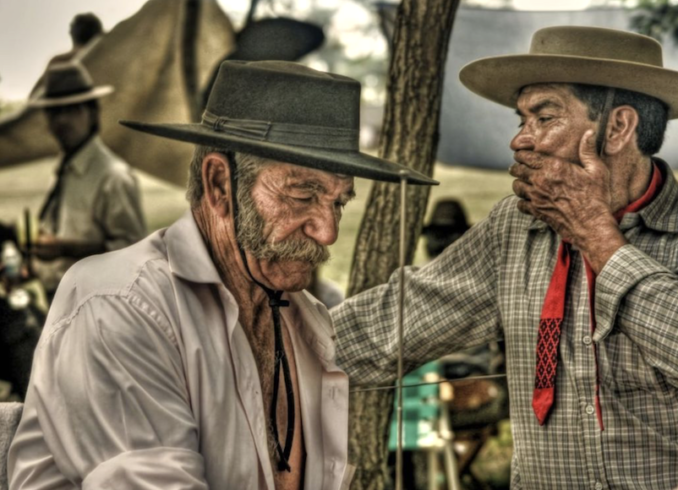More writings by uncle, John Alldridge. This time he is reporting from South America in 1960 for the Birmingham Evening Mail – Jerry F
Caution: This article contains descriptions which some may find upsetting – Jerry F
It was spring once again in Buenos Aires. My second spring in a year. All along the Santa Fe, the city’s Fifth Avenue, the flower sellers were making up posies of freesias and anemones and dwarf daffodils.

Avenida 9 de Julio,
John Spooner – Licence CC BY-SA 2.0
Bearded young artists were sketching away like mad. Poets were distributing free samples of their verses.
And caught up in this riot of spring, the whole vast ant-heap of a city seemed to be trying frantically to look more like Paris than Paris itself.
But I was not here to smell the flowers. I had flown in by Pan-American and had an appointment with Death …
If that sounds a trifle melodramatic to you, remember that the Argentine is the world’s greatest provider of meat. Half the steaks you have ever eaten have come from here. A political upheaval in Buenos Aires, the slightest financial juggling between here and Smithfield, and you will see it reflected in the size of your Sunday joint.
It is a sobering thought to think that, just five weeks ago, that same joint you enjoyed last Sunday was probably frisking around, as free as air, not a hundred miles from where I’m writing this.
Beef on the hoof has always been the Argentine’s greatest blessing — and its greatest headache.
Much of the fattest land in this fat land where life is inexhaustible is held by individual landowners whose estancias (ranches) reach fabulous size.
In Buenos Aires province alone 50 families have holdings of 75,000 acres or more; the holdings of these 50 cover 15.2 per cent of the whole province.
The names of these great landowners may be English, Irish, Spanish, Scots, German, Italian. But all are Argentinian. These landowners may make money and build factories with it, but the proceeds always go back into the land, to raise even more fabulous prize bulls.
Their abiding fear is that if the country becomes thoroughly industrialised it will no longer import manufactured goods, which would mean drastic reductions in the export of their beef.
So the clash of industry and agriculture here is war to the knife.
The Spaniards brought the first cattle to South America four centuries ago. They also brought the first grass seed. And so the cattle were seen roaming wild on the rich, lush meadowland of the Pampas.
There they bred and multiplied. Until today there must be 30 or 40 million of them; still roaming free, summer and winter; still finding their own food; still mating and calving without a man to see or help them.
For two and a half happy years they live in Paradise. Then one morning they are rounded up and packed into freight cars bound for Buenos Aires.
Two days later they come up for auction at Liniers market, on the outskirts of the city. This is the largest stockyard in the world. Through those white corral gates stampedes a never-ending flood of beef.

Liniers Cattle Market, Buenos Aires,
Beatrice Murch – Licence CC BY-SA 2.0
On the morning I visited it 12,000 cows and bulls were bought and sold in five hours. And this, they explained, was the quiet time of year, between seasons. It is a hectic place: something between a bull-ring and a rodeo in atmosphere. Everything is done on horseback, and at the gallop. Buyers from the frigorificos (packing houses) gallop up to the pen, bid for a hundred head or so, and gallop on to the next lot.
Then small boys with branding irons dipped in white paint gallop inside the pens and start stamping the cattle with the brand of their new owners.
Two friends will spy each other at opposite ends of the muddy avenues and gallop over to shake hands. I have not seen so many horses since the Coronation. And as the only man there not on horseback I had to step lively to avoid being trampled underfoot.
Now I am no cattleman and no great animal-lover, but the sight of those cattle shocked and sickened me.
They were dirty and travel-stained. Their coats were matted with mud and sweat. And many of them were rubbed raw and bleeding. While I watched, a herd of maybe 50 head was stampeded into a sale-pen. At the entrance one cow stumbled and fell heavily.
It was obvious that she had broken a leg. But she lay there all morning in the blinding sun. Nobody attempted to move her; or apparently even considered it. And each new intake as it was driven into the pen, had to clamber over her body.
She was still alive when I left. It will be a long time before I forgot the look of dumb resignation in that poor beast’s eyes.
The next day, at the slaughterhouse, I met some of those animals again. Though they did not know it, they had almost reached Journey’s End.
They were splashing about delightedly in a huge artificial pool, snorting with pleasure as a fine spray of water washed them down and cooled them off.
The bath did not last long. Then a stab drove them in single file up a steep ramp. The ramp of death.
At the top of the ramp they can smell it. And they try to turn back. But another jab with an electric goad drives them forward, until they are wedged, five at a time, in a narrow alley.
Above them, and out of their sight, stands a man with a long-handled hammer. Rhythmically, with the grace of a golf professional, he swings his hammer and cracks it down on the heads below. One blow is usually enough. When all five have been stunned, the wooden side of the alley drops and the numb but still twitching bodies fall to the floor below.
But only for a second. Then they are caught up by the heels and swung like so many sacks to the men with the knives.
With the skill of a practised surgeon the first man slits the dewlap and neatly severs the jugular. In the minute it takes to swing it to the next butcher, the beast has bled to death.
In five minutes it is not recognisable as a beast at all, just a carcass; skinned, flensed, jointed, ready for the chilling-room and then the three-week journey on the fast refrigerator ship to England; kept a constant four degrees above freezing: and cared for like first-class mail. Add another week and it could be on your table …
And so it goes on, this mechanised killing. This death by conveyor-belt; 320 beasts an hour on the day I was there. Or 2,300 in the day.
I was invited to see the sheep slaughtered, too, but I declined. I’d seen enough for one morning. For many mornings…
This frigorifico of meat preparing and storage unit is the largest in the world. It is British-owned and operated; and in recent years it has survived a number of dramatic and well-nigh overwhelming disasters with superb tenacity.
During the war most of its refrigerator ships were sunk. Then for 12 years Peron fanatic nationalism and hare-brained “reforms” nearly put it out of business.
It was not, for instance, permitted to import much-needed new equipment.
Even now, when herds are slowly returning to their old pre-war sizes, it is facing up to the threat of competition from a State-owned, State-subsidised rival. For all that, half a million carcasses of beef were sent out from here last year. And heaven knows how many cans of corned beef, tinned tongue and beef extract.
Which you will agree is still an awful lot of meat. Enough to turn you vegetarian at the very thought of it.
The tough gentleman of the Pampas. He loves his horse, his dog and his wife – in that order
We were driving about a hundred miles north of Buenos Aires — to which I had flown by Pan-American — to buy steers from a small estancia (ranch) called Los Tres Carlitos (The Three Charlies).
There were three of us in the party. There was the cattle buyer for the big packing house. His name is Gordon Campbell and he is the third generation of Argentine Scots who came originally to farm sheep from Glaserton, in Wigtownshire.
Campbell is a tall, rangy character, very much like the film actor, John Gregson, to look at. He has been a cattleman all his life, and like most of his fellow Scots born in Argentina has dual nationality, speaks Spanish fluently but has never lost his Scots accent.
(A curious thing, this. The Scots and the Irish settled in Argentina in their thousands towards the end of the last century. The Irish have become completely integrated until they hardly speak a word of English. But the Scots remain almost more Scottish than the Scots).
With us, too, was the cattle broker. For in Latin America no business deal is possible without the intervention of the “middle-man.” He was a happy character who spoke no English but had an international sense of humour.
For two hours we drove through some of the loneliest —and yet liveliest — countryside I have ever experienced. It was as flat as Holland, but greener. Covered for mile after mile, clear out to the unbroken horizon, by a carpet of emerald grass.
In places it was quite thickly wooded; mainly by groves of eucalyptus. And it came as a shock to me to learn that every one of those trees was planted by man. And that the lushness of that green depends largely on windmill pumps. For in this vast meadowland there are no rivers or brooks; and no ponds or pools except after exceptionally heavy rain.
It is monotonous country, rolling for mile after mile inside the same eternal wire picket fence, which is always the same height and never varies in design. The posts are always of hard quebracho wood, and each exactly the same distance from the next. And never more than one strand of barbed wire in the four that stretch taut for 50 miles at a time and sing like a harp in the wind.
Yet I have never heard such a throbbing variety of life. You rarely see a man. But I counted deer and hawks and pheasant; owls watching, unblinking, from gateposts; an ostrich poking a curious head from over a field of barley; enormous horses and king-size rabbits.
Of course, everywhere, the tiny ovenbird, standing guard over the two-room apartment he builds each year out of a ball of mud sited squarely on top of a fence-post.
“The Three Charlies” is a small ranch as ranches go out here. It is around 3,000 acres and rears about 1,500 head of cattle, mostly Shorthorn and Aberdeen Angus.
For three generations it has been owned by the same family. The eldest son in each case was christened Carlos, hence the name.
The present owner, Don Carlos Alberto Pazzaglia, is a youngish man. He has the chunky figure of a good dependable second-row forward, which in fact he was in his playing days.
Like many small ranchers he prefers to live in the town.
He leaves the routine running of the estancia in the safe hands of his foreman and his three gaucho cowboys.
It was these gauchos I had really come to see. For in Argentina, more so than anywhere else, they have become a legend.
The gaucho is a gentleman. “He is a true gaucho,” they say of a man here. He may never have ridden a horse, but it is the highest compliment they can pay him.
Unlike the Western cowboy the gaucho is a peace-loving man who rarely gets drunk and almost never gets into a fight.

Los gauchos,
José María Pérez Nuñez – Licence CC BY-SA 2.0
He loves three things above all: his horse, his dog, and his wife — in that order. He is a simple, uncomplicated character, intensely loyal and easily hurt. Don Carlos’s three gauchos have been with him for 10 years. He pays them about £3 a week and their keep. Which means a small plot of land to till and all the beef they can eat.
They eat practically nothing else but beef, and they cook it their own way — wrapped round a spit like a two-handled sword, and grilled slowly in the open air over a charcoal fire.
They are old-time conservatives in their dress. They stick obstinately to their famous baggy bombacha pants, to their wide, silver-studded belts, and round felt hats.
They may prefer canvas shoes to boots in their huge hooped stirrups. The traditional bolas — the lariat with the balls of weighted leather on the receiving end — may be carried under the saddle for decoration now. But the wicked knife, slung between the shoulder blades, is no decoration.
It has a dozen very practical uses, from skinning a calf to killing a rattlesnake.
They prefer to sleep outdoors in a thatched lean-to under the stars. But they can be coaxed into the bunkhouse on frosty nights. When Don Pedro put electric light in his bunkhouse they threatened to quit. The Padrone was going soft, they complained.
Watching them at work — cutting out the steers as Campbell picked them, or resting, sitting side-saddle, with one knee on the horse’s neck — I was fascinated by the grace with which they moved; a grace so easy and natural that it hardly disturbs the ash hanging from the inevitable cigarette.
The movements of horse and man are one carefully coordinated reflex action. This is not a man on a horse you are watching. This is a centaur…
They are a slow-dying race. Their days were already numbered 70 years ago when the wire began to fence in the range. But somehow they hang on, obstinately.
I heard of an old gaucho who, at over 80, was breaking in a new horse. When they told him he should put away worldly things at his age he pointed to the wide green pampas, stretching to infinity, like a green sky speckled with black and white stars.
“How can a man die when all that is still there?” he said.
The Argentinians are good at telling stories against themselves. One going the rounds just now jibes neatly at inflated prices which bob up and down like ping-pong balls.
A woman queueing for a ticket at a Buenos Aires railway station found that the fare had doubled since yesterday. “Curse the British!” she said. “Curse the British!”
“But madame,” explained the ticket clerk, “the British sold out the railways years ago. Now they belong to us.”
“I know,” said the woman. “And that’s why I say ‘Curse the British!'”
Reproduced with permission
© 2023 Newspapers.com
Jerry F 2023



